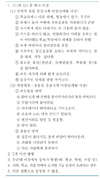Abstract
Attention-Deficit /Hyperactivity Disorder(ADHD), previously considered as a disease of childhood, is a disorder characterized by inattention, hyperactivity, and impulsivity. Recent studies, however, revealed that in about a half of the ADHD children the patients continue their symptoms into their adulthood, which implicates that ADHD is not a childhood disorder but a disorder that a patient has to live with for his or her life. The prevalence of ADHD is 2~6% of general population, with a male preponderance. Since ADHD usually develops in school ages, patients experience such problems as learning difficulties, maladjustment, depressive episodes, substance use, and conflicts with parents or other children. Co-morbidities, e.g. tic, anxiety conduct, and oppositional defiant disorders also exist. Although the exact etiology of ADHD remains to be elucidated, abnormalities of specific areas and pathways in the central nervous system, which is reflected by the term, ADHD-minimal brain damage or minimal brain dysfunction in the early 20th century, have been reported. Genetic factors also have to be considered. To establish the diagnosis of ADHD, the behavior of children and collateral information are required. Objective tests including intelligence, neuropsychological tests, and continuous performance test are helpful. Pharmacotherapy and family education are the most important elements in treating ADHD patients. Cognitive-behavior therapy, play therapy, and social skill training are also useful. A CNS stimulant such as methylphenidate is the most commonly prescribed drug, and the prescription of newly developed drugs, atomoxetine and modafinil, is increasing. The success of treatment depends on both medication and management of psychological and behavioral problems. Early diagnosis and intervention can improve the prognosis of the patients.
References
2. Clements S. . Minimal brain dysfunction in children(National Institute of Neurological Diseases and Blindness, Monograph No.3). 1966. Washington DC: US Department of Health, Education, and Welfare.
3. Wender PH. Attention-Deficit Hyperactivity Disorder in Adults. 1995. New York: Oxford University Press.
4. Anderson JC, Williams S, McGee R, Silva PA. DSM-III disorders in preadolescent children. Arch Gen Psychiatry. 1987. 44:69–76.

5. Bird HR, Canino G, Rubio-Stipec M, Gould MS, Ribera J, Sanchez-Lacay A, et al. Estimate of the prevalence of childhood maladjustment in a community survey in Puerto Rico. Arch Gen Psychiatry. 1988. 45:1120–1126.

8. Szatmari P, Offord DR, Boyle MH. Ontario child health study: Prevalence of attention deficit disorder with hyperactivity. J Child Psychol Psychiatry. 1989. 30:219–230.

9. Biederman J, Faraone SV, Spencer T, Wilens T, Norman D, Doyle A, et al. Patterns of psychiatric comorbidity, cognition, and psychosocial functioning in adults with attention deficit hyperactivity disorder. Am J Psychiatry. 1993. 150:1792–1798.

10. McGee R, Feehan M, Williams S, Partridge F, Silva PA, Kelly J. DSM-III disorders in a large sample of adolescents. J Am Acad Child Adolesc Psychiatry. 1990. 29:611–619.

11. Hesslinger B, Tebartz van Elst L, Nyberg E, Dykierek P, Richter H, Ebert D, et al. Psychotherapy of attention deficit hyperactivity disorder in adults A pilot study using a structured skills training program. Eur Arch Psychiatry Clin Neurosci. 2002. 252:177–184.
12. Pary R, Lewis S, Matuschka PR, Lippmann S. Attention-deficit / hyperactivity disorder: an update. South Med J. 2002. 95:743–749.
13. Wender PH. The minimal brain dysfunction syndrome in children: I. The syndrome and its relevance for psychiatry. II. A psychological and biochemical model for the syndrome. J Nerv Ment Disease. 1972. 155:55–71.
14. Hechtman L. Lewis M, editor. Developmental neurobiological and psychosocial aspects of hyperactivity, impulsivity & attention. Child and Adolescent Psychiatry: A comprehensive textbook. 1996. Baltimore: Williams & Wilkins;323–334.
15. Sprich-Buckminster S, Biederman J, Milberger S, Faraone SV, Lehman BK. Are perinatal complications relevant to the manifestation of ADD? Issues of comorbidity & familiality. J Am Acad Child Adolesc Psychiatry. 1993. 32:1032–1037.

16. Barkley RA, Fischer M, Smallish L, Fletcher K. The persistence of attention-deficit/hyperactivity disorder into young adulthood as a function of reporting source and definition of disorder. J Abnorm Psychol. 2002. 111:279–289.

17. Mannuzza S, Klein RG, Bessler A, Malloy P, LaPadula M. Adult psychiatric status of hyperactive boys grown up. Am J Psychiatry. 1998. 155:493–498.

18. Weiss G, Hechtman LT. Hyperactive children grown up. ADHD in children, adolescents, and adults. 1993. 2nd ed. New York: Guilford.
19. American Psychiatric Association(APA). Diagnostic and Statistical Manual of Mental Disorders, TRTM.(DSM-IV-TRTM). 2000. Washington DC:
20. World Health Organization (WHO). The ICD-10 classification of mental and behavioural disorders: Clinical descriptions and diagnostic guidelines. 1992. Geneva: WHO.
21. Goyette CH, Conners CK, Ulrich RF. Normative data on revised Conners Parent and Teacher Rating Scales. J Abnorm Child Psychol. 1978. 6:221–236.

23. The MTA Cooperative group. A 14-month randomized clinical trial of treatment strategies for attention-deficit / hyperactivity disorder. The MTA Cooperative Group. Multimodal Treatment Study of Children with ADHD. Arch Gen Psychiatry. 1999. 56:1073–1086. 1088–1096.
24. Coleman WL, Levine MD. Attention deficits in adolescence: description, evaluation, and management. Pediatr Rev. 1988. 9:287–298.

25. American Academy of Child & Adolescent Psychiatry(AACAP). Practice parameter for the use of stimulant medications in the treatment of children, adolescents, and adults. J Am Acad Child Adolesc Psychiatry. 2002. 41:26S–49S.
26. Hunt RD, Minderaa RB, Cohen DJ. Clonidine benefits children with attention deficit disorder and hyperactivity: Report of a double blind placebo-crossover therapeutic trial. J Am Acad Child Adolesc Psychiatry. 1985. 24:617–619.
27. Chappell PB, Riddle MA, Scahill L, Lynch KA, Schultz R, Leckman JF, Cohen DJ, et al. Guanfacine treatment of comorbid attention-deficit hyperactivity disorder and tourette's syndrome: Preliminary clinical experience. J Am Acad Child Adolesc Psychiatry. 1995. 34:1140–1146.

28. Mannuzza S, Klein RG. Quay HC, Hogan AE, editors. Adolescent and adult outcomes in attention deficit / hyperactivity disorder. Handbook of disruptive behavior disorders. 1999. New York: Kluwer Academy/Plenum Publishers;281.
29. Weiss G, Hechtman L, Milroy T, Perlman T. Psychiatric status of hyperactives as adults: A controlled prospective 15-year follow-up of 63 hyperactive children. J Am Acad Child Adolesc Psychiatry. 1985. 24:211–220.

30. Mannuzza S, Klein RG, Bessler A, Malloy P, LaPadula M. Adult outcome of hyperactive boys: Educational achievement, occupational rank, and psychiatric status. Arch Gen Psychiatry. 1993. 50:565–576.




 PDF
PDF ePub
ePub Citation
Citation Print
Print





 XML Download
XML Download